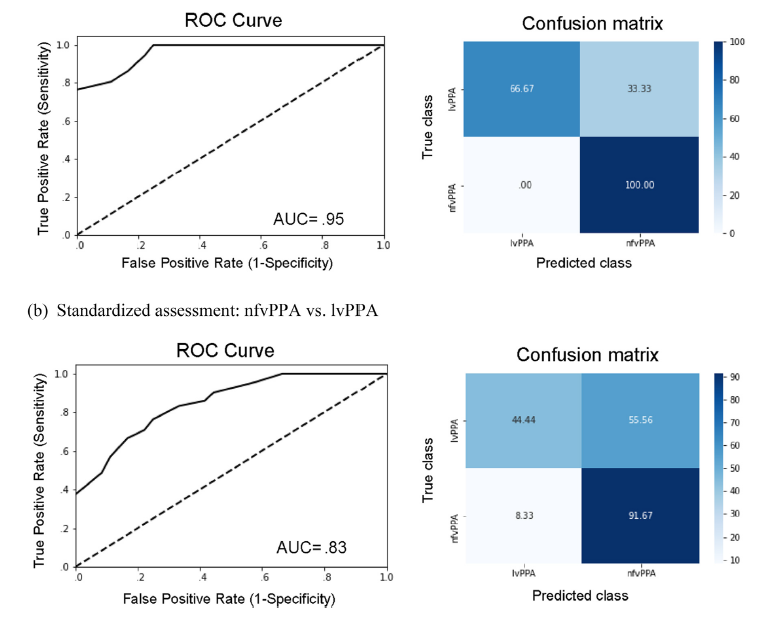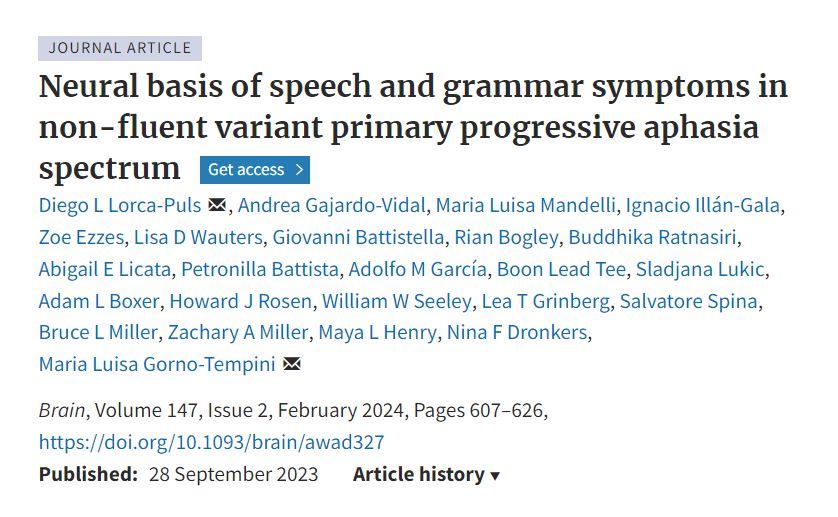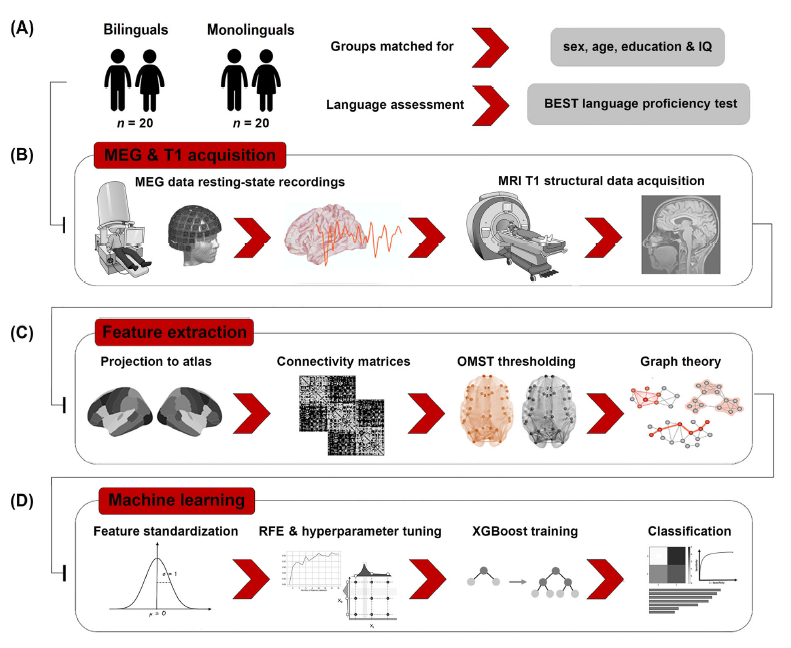Discriminating nonfluent/agrammatic and logopenic PPA variants with automatically extracted morphosyntactic measures from connected speech
Lukic, S., Fan, Z., García, A. M., Welch, A., Ratnasiri, B., Wilson, S., Henry, M., Vonk, J., de Leon, J., Miller, B., Miller, Z., Mandelli, M. L. & Gorno-Tempini, M-L. (2024). Discriminating nonfluent/agrammatic and logopenic PPA variants with automatically extracted morphosyntactic measures from connected speech. Cortex 173, 34-48.
Las evaluaciones morfosintácticas son importantes para caracterizar a los individuos con la variante no fluente/agramática de la afasia primaria progresiva (APPvnf). Sin embargo, las pruebas estándar están sujetas al sesgo del examinador y a menudo no diferencian entre la APPnf y la variante logopénica de la APP (APPvl). Además, las bases neuronales relevantes siguen sin explorarse lo suficiente. Aprovechamos herramientas de procesamiento del lenguaje natural para capturar automáticamente alteraciones morfosintácticas y sus correlatos neuroanatómicos en 35 individuos con APPvnf en relación con 10 controles sanos (CS) y 26 individuos con APPvl.
Los participantes describieron una imagen y las transcripciones resultantes se analizaron mediante el etiquetado de parte del discurso para extraer características relacionadas con la frase (por ejemplo, conjunciones subordinantes y coordinantes), características relacionadas con el verbo (por ejemplo, marcadores de tiempo) y características relacionadas con el nombre (por ejemplo, pronombres subjetivos y posesivos). Se utilizaron máquinas de gradient boosting para clasificar entre grupos utilizando todas las características. Se identificó el marcador morfosintáctico más discriminante mediante un algoritmo de importancia de rasgos y se examinaron sus correlatos neuronales mediante morfometría basada en vóxeles.
Los individuos con APPvnf emitieron menos elementos morfosintácticos que los otros dos grupos. Dichos rasgos los discriminaron de forma robusta tanto de los individuos con APPvl como de los CS con un AUC de .95 y .82, respectivamente. El rasgo más discriminatorio correspondiente a las conjunciones subordinantes se correlacionó con la atrofia cortical dentro de la circunvolución frontal inferior posterior izquierda en todos los grupos (pFWE < .05).
El análisis morfosintáctico automatizado puede diferenciar eficazmente la APPvnf de la APPvl. Además, los marcadores morfosintácticos más sensibles se correlacionan con una región de atrofia central de la APPvnf. Nuestro enfoque, por tanto, puede contribuir a un reto clave en el diagnóstico de la APP.
Para acceder al artículo, hacé click aquí.
Discriminating nonfluent/agrammatic and logopenic PPA variants with automatically extracted morphosyntactic measures from connected speech
Lukic, S., Fan, Z., García, A. M., Welch, A., Ratnasiri, B., Wilson, S., Henry, M., Vonk, J., de Leon, J., Miller, B., Miller, Z., Mandelli, M. L. & Gorno-Tempini, M-L. (2024). Discriminating nonfluent/agrammatic and logopenic PPA variants with automatically extracted morphosyntactic measures from connected speech. Cortex 173, 34-48.
Morphosyntactic assessments are important for characterizing individuals with nonfluent/agrammatic variant primary progressive aphasia (nfvPPA). Yet, standard tests are subject to examiner bias and often fail to differentiate between nfvPPA and logopenic variant PPA (lvPPA). Moreover, relevant neural signatures remain underexplored. Here, we leverage natural language processing tools to automatically capture morphosyntactic disturbances and their neuroanatomical correlates in 35 individuals with nfvPPA relative to 10 healthy controls (HC) and 26 individuals with lvPPA.
Participants described a picture, and ensuing transcripts were analyzed via part-of-speech tagging to extract sentence-related features (e.g., subordinating and coordinating conjunctions), verbal-related features (e.g., tense markers), and nominal-related features (e.g., subjective and possessive pronouns). Gradient boosting machines were used to classify between groups using all features. We identified the most discriminant morphosyntactic marker via a feature importance algorithm and examined its neural correlates via voxel-based morphometry.
Individuals with nfvPPA produced fewer morphosyntactic elements than the other two groups. Such features robustly discriminated them from both individuals with lvPPA and HCs with an AUC of .95 and .82, respectively. The most discriminatory feature corresponded to subordinating conjunctions was correlated with cortical atrophy within the left posterior inferior frontal gyrus across groups (pFWE < .05).
Automated morphosyntactic analysis can efficiently differentiate nfvPPA from lvPPA. Also, the most sensitive morphosyntactic markers correlate with a core atrophy region of nfvPPA. Our approach, thus, can contribute to a key challenge in PPA diagnosis.
To access the full paper, please click here.



